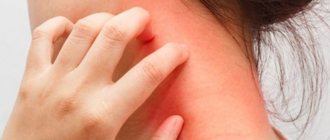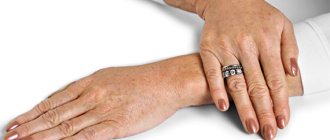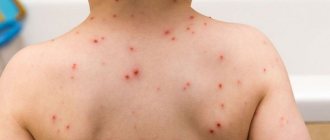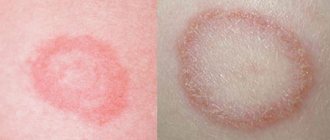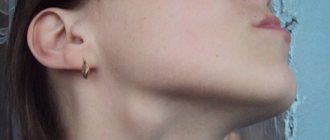Ringworm-like spots on the body may itch or cause no noticeable discomfort. There are several types of lichen, which appear in the form of nodules, spots, and plaques. Similar symptoms may indicate other pathologies. For proper treatment, it is necessary to find out the main cause of changes in the skin. If spots on the body that look like lichen do not itch, the doctor will determine what it is and prescribe therapy.
Red spots on the skin of the body, similar to lichen
Quite often, people may experience reddish spots on their skin. They can have completely different shapes and sizes, colors, and be flat or protruding. The spots may peel, itch with varying intensity, and when you touch them, you may experience high skin sensitivity, sometimes bordering on pain.
If the spots itch?
In most cases, the appearance of spots on the skin is accompanied by itching sensations of varying severity. Spots are formed due to damage to the skin by various microorganisms or other factors of the body or environment.
And the skin begins to itch due to a certain allergic reaction caused during the process of sensitization of the body, the release of various toxins. Also, during this process, increased production of histamine begins, which, in turn, also affects itching and other unpleasant sensations.
What if the spots don't itch?
There are cases when the spots that appear do not itch at all. Therefore, a person does not notice them immediately, or may not notice them at all - especially if they appear in hard-to-see places, for example, under the hair.
Such spots can appear due to infectious influences, allergies, poor and unbalanced nutrition. Stress can also affect your skin in the same way.
Read more about skin diseases, when red spots on the body do not itch, and what it could be.
Other causes of lichen-like spots on the body and their treatment
If spots on the body that look like lichen itch or don’t itch, only a doctor can tell you how to treat it. There are many reasons, and it is important to get the correct diagnosis. What other reasons could there be for the appearance of such formations on the skin?
Dark spots
Brown skin coloring occurs due to a lack or excess of pigment in the tissues. Common reasons for their appearance are:
- hormonal changes
- liver failure,
- gynecological diseases,
- metabolic disorder,
- avitaminosis.
Lyme disease
This infectious disease, borreliosis, is transmitted through the bite of a human by an ixodid tick. A spot forms at the site of the lesion, which gradually increases and can reach a diameter of 20 cm. In the center, the skin is pale, along the edges there is redness, swelling, and pain when pressed. New outbreaks cannot be ruled out.
At the same time, intoxication of the body occurs, weakness is felt, lymph nodes become enlarged, joints, liver, and head hurt.
In case of illness, comprehensive treatment in a hospital is necessary. Timely access to the clinic is of great importance. Therefore, if spots on the body appear on the body that look like lichen, they itch, photos on the Internet will not give you the opportunity to figure it out on your own, you need to urgently seek qualified medical help.
Allergic reaction
The appearance of acne and redness on the skin can be caused by wearing underwear made of synthetic materials, using low-quality cosmetics, hypothermia, eating certain foods, and taking medications. In some cases, the symptoms are identical to those of lichen and are cause for concern.
Depending on the complexity of the reaction, treatment is selected. To eliminate formations, it may be enough to avoid contact with the allergen. But sometimes long-term treatment with antihistamines is required.
Read also: Itching in the intimate area in men: why does the intimate area itch?
Ring-shaped erythema
The disease affects young men. Spots appear on the body, similar to lichen, they itch slightly or there is no itching at all, and they peel off. The formations are constantly increasing, forming rings, half-rings, and various “patterns.” A pink edging is visible along the edge, but in the center the skin remains unchanged.
To eliminate the disease, treatment of the respiratory and digestive system begins. For treatment, hormonal ointments are prescribed, and antihistamine tablets are prescribed orally.
Alopecia areata
The cause of partial baldness is not fully understood. Autoimmune death of hair follicles is suspected. The only symptom of the disease is the absence of hair on the scalp. Pathology manifests itself in different forms: lesions with pronounced bald spots, loss of up to 40% of hair, loss along the edges, on the back of the head or crown.
The treatment is long-term. Prescribe Prednisolone for at least 1.5 months with a gradual reduction in dose, injections of nicotinic acid, zinc oxide, and injection of hormones into the affected area.
Seborrheic dermatitis
The main reason for the development of the disease is increased sweating. Symptoms of the disease: flaky yellowish spots with a pronounced edging. Cracks and crusts are observed in the folds of the skin. Often pathogenic microorganisms attach to the affected areas, causing inflammation.
Treatment is long and complex. They prescribe Prednisolone, Betamethasone, and sedatives to restore the nervous system and get proper sleep. For external treatment, use brilliant green, pastes based on birch tar, naphthalan.
In most cases, the functioning of the digestive organs is disrupted, so ox bile extract, cholic acid, and Pancreatin are recommended.
Pseudopelada
The disease is rare and is classified as a type of alopecia. It appears in men under the age of 45 and is discovered by chance when there is no hair in some places on the head. This is due to a malnutrition of the hair follicles caused by nervous shock. The affected areas can be of different sizes and shapes, sometimes merging with each other.
If the disease is detected, the remaining hair is shaved off and sulfur, tar, and mercury ointments are rubbed into the skin. Twice a day, shower your head with a hot shower using special soap.
Spots similar to lichen are a manifestation of this or other diseases. Sometimes they go away on their own, but can cause complications not only of an aesthetic nature: in some cases, the functioning of internal organs is disrupted. Timely diagnosis and proper treatment will help avoid complications.
Lichen
Ringworm is almost the most common cause of spots on the skin.
Spots can appear in various areas of the skin:
- on the chest;
- on the back;
- on the stomach and groin;
- on the neck and also the face;
- on the skin of the hands or feet.
Ringworm can be of different types:
- Pityriasis rosea . This type of lichen mainly affects teenage children. Pityriasis rosea is relatively easy for a child to tolerate; recovery occurs within a few weeks, or less often, months. The disease progresses as follows. First, on the surface of the skin at the site of lichen, one spot appears several centimeters in size, bright pink in color and often with a border of different shades. After a week or two, additional spots appear. Pityriasis rosea is always accompanied by itching, and occasionally mild pain. Another article presents a photo of pityriasis rosea in humans.
- Ringworm. It appears in both middle-aged children and adults. The spots can appear both on the scalp and on the skin of the body or limbs. With ringworm, the skin itches and flakes relatively severely, and the hair in these areas becomes brittle and falls out. This is where the name of this type of lichen comes from.
- Shingles. This type is caused by a virus called chickenpox. That’s why it develops in most cases in adults, since children get chickenpox when infected. Shingles primarily affects the ribs, but in rare cases it can appear on other parts of the body. The disease is accompanied by severe itching and the appearance of blisters with watery liquid. The blisters burst after a few days, and in their place the skin becomes covered with a crust.
- Lichen planus. It is characterized by the appearance of a rash on the surface of the skin, most often in the chest or abdomen, less often on the arms or the front of the lower leg. The color of the rash is red, the shade can be different - from bright red to brown, or even bluish. The person feels severe itching in the area of the rash, but no peeling is observed. The spots can increase in size, up to 10-13 centimeters.
- Pityriasis alba. White spots appear on the human body, usually on the face or limbs, up to five centimeters in size. What is noteworthy: pityriasis alba spots practically do not bring any discomfort to the patient. It is very rare to observe peeling or inflammation of the skin in these places. But this type of lichen is also chronic and can appear even if the body has not been exposed to infection or any other disturbances in its functioning.
- Tinea versicolor. A peculiarity of this type of disease is that the spots that appear on the skin tend to change their color over time. The first spots that appear are yellow or yellowish-brown in color. Over time, their number and size increase, and the spots begin to merge with each other. And after that, their color begins to change, the spots darken and become completely brown or brown. They are always flat, always flaky, but never cause an itching sensation. They appear everywhere on the body: on the sides, stomach, chest, shoulders and back, occasionally on the neck and even less often on the face.
You might be interested! What diseases cause red spots on the skin?
Ringworm in the photo
Diagnostic methods for determining the type of lichen
The diagnosis should be made by a specialist with a higher medical education: a dermatologist. Sometimes patients with signs of lichen can be seen by a dermatovenerologist, urologist, or gynecologist - if the rash appears in the groin area. Also, people with signs of lichen can turn to cosmetologists, trichologists and other specialists.
Most of the lichens are identified already at the first consultation. The doctor conducts a survey, examines the rash visually, and then using a dermatoscope, magnifying glass, or Wood's lamp (some types of rash have a specific glow in ultraviolet light). Sometimes the doctor may need to tint the rash with a solution of iodine or other dyes to identify its morphology and features.
Microscopic and cultural examination has important diagnostic value. To do this, scrapings are taken from the patient's skin, hair, and nails. The material is treated with special reagents and examined under a microscope. For example, if a fungus is suspected, alkali is used to dissolve the cell walls and release the mycelial hyphae. To exclude false-negative variants, the scraping material is sown on a nutrient medium and the growth of the culture is observed. The diagnosis is made by the type, shape, and size of the grown fungi.
For some types of lichen, PCR or ELISA is done to isolate specific DNA fragments of the pathogen (for example, for herpes zoster).
If concomitant factors play a large role in the occurrence of the disease (with weeping, multicolored lichen), neurologists, geneticists, immunologists, endocrinologists and other specialists can be involved in the diagnosis. They will use additional diagnostic methods (laboratory, instrumental, etc.) [1-4].
Allergy
Red spots on the skin may be signs of an allergic reaction to something. More precisely, one of the types of allergic reactions, since it can manifest itself in different ways. Spots on the body appear due to the body’s contact with an irritant - it can be different, from food to various medications.
Photos of allergies
Ringworm “as a keepsake”: the most common skin problems after COVID-19 are named
Source: "DoctorPeter" Date: 07/23/2021
Hair loss and skin rashes are common complaints among those who have recovered from COVID-19. As the City Committee for Internal Affairs said, doctors have not yet identified exclusively “Covid” skin problems - many of them also arise with other diseases.
Related to COVID-19, but not certain
According to Elena Moshkova, dermatologist of the City Clinical Infectious Diseases Department, no special skin rash characteristic only of coronavirus infection has yet been identified.
— Taking into account the still short period of observation of patients with COVID-19 and skin manifestations, it cannot be stated unequivocally that there are pathognomonic skin rashes (unambiguously describing a specific disease - editor's note), and they can be used to confirm infection with the new virus. Quite the contrary. The patient knows that he has a history of coronavirus infection, and the doctor can conclude that these skin manifestations are most likely associated with a viral disease, Elena Moshkova told Doctor Peter.
The doctor named the 5 most common skin complications after Covid with which patients come to the City Clinical Hospital.
Pink lichen of Zhiber
It appears as round, scaly spots usually up to 2 cm in diameter. Over time, the central part of the spot fades, but the edges remain quite bright. Patients may experience itching, but not always - this is individual. According to Elena Moshkova, Zhiber’s pityriasis rosea can occur not only after Covid, but also against the background of a common ARVI, and in other situations when immunity is reduced.
“It is important that this dermatosis is not contagious and for most it can go away within a few weeks even without treatment. Such patients rarely require the use of glucocorticosteroid creams and systemic therapy, the dermatologist said.
Skin vasculitis
Another common problem.
Skin vasculitis is characterized by hemorrhagic spots, which fade over time like small bruises. Some people, most often older people, may develop areas of necrosis - dead cells - on the skin. — The coronavirus that causes COVID-19 is tropen (prefers - editor's note) to vascular receptors. Therefore, it is not surprising that skin vessels can also be affected, often on the hands and feet. However, the diagnosis of “vasculitis” existed in dermatology even before Covid, the doctor adds.
Rashes
Toxic-allergic rashes also occur in those who have recovered from the disease . However, according to Elena Moshkova, in most patients with such problems, doctors cannot determine for sure whether this is a consequence of COVID-19 or a reaction to taking medications in the treatment of a viral disease.
In addition, those with a high fever may suffer from common heat rash - this often goes away on its own, but in some cases special medications may be required to reduce the itching. After a coronavirus infection, doctors also observe urticaria-type , usually on the skin of the palms. According to Elena Moshkova, if you have urticaria, you still need to go to the doctor - he will conduct a differential diagnosis, because it can be confused with a variant of skin vasculitis.
Rare, but without bald spots
Those who have recovered from Covid go to the City Clinical Internal Affairs Department not only with rashes and spots on the skin. Both men and women are often worried about another post-Covid problem - hair loss, as “Doctor Peter” has written about more than once. Hair does not begin to fall out immediately, but only several months after the illness. As doctors specify, the hairline thins, but bald spots do not form.
— The main reason is impaired blood circulation in the scalp due to damage to the vascular walls. Plus, stress, concomitant intoxication, and drug therapy for the disease contribute to this. And under unfavorable conditions, the alternation of phases of activity and rest of the hair follicles is disrupted. This happens regardless of the severity of Covid - everything is individual,” explains Elena Moshkova.
According to the doctor, usually over time, blood supply to the scalp is restored and hair density returns to normal. Good nutrition also helps speed up the solution. However, consulting a trichologist in this situation may not be superfluous, especially if the problem is too noticeable.
* Nadezhda Krylova
Infections
Sometimes red spots on the skin indicate the presence of a certain infectious disease.
Such diseases include:
- chickenpox;
- scarlet fever;
- rubella;
- measles;
- venereal diseases (syphilis).
In any case, to find the right treatment, you need to see a doctor.
Photos of manifestations of infectious diseases
Syphilis
When suffering from syphilis, the appearance of red spots on the patient’s skin is considered to be the primary and secondary signs of this disease.
Stages of syphilis:
- The primary stage lasts about seven weeks. The red spot first appears flat and small in size. After a few days, the spot grows in height, becoming a noticeable bump. After this, the process of tissue death begins in the center of the tubercle. As a result, an ulcer remains on a person’s skin, ringed with hardened edges - a chancre. It does not cause painful sensations.
- Second stage Syphilis is much more diverse, which makes it similar to other diseases. It is characterized by a rash on the skin, the so-called syphilitic rash. The rash usually has the following features:
- the color of the rash is red, dark in color;
- characteristic unpleasant sensations (itching, pain) are absent;
- the rash is round, clear, does not increase in size and does not merge;
- the rashes are densely located;
- peeling is weak or completely absent;
- Self-healing is possible without atrophy and scarring.
Manifestation of syphilis in the photo
The main forms of lichen and methods of their treatment
Ringworm is a term used to refer to skin diseases of various etiologies. They differ in symptoms, causes and consequences, and do not always cause itching. Therefore, if a spot appears on the skin that looks like lichen, but does not itch, you still need to consult a doctor. Drug therapy and diet may be required.
There are 8 forms of the disease:
- Shingles . In children it manifests itself as chickenpox; in adults it affects a large area of the ribs. It is characterized by the appearance of small watery blisters that burst. A crust forms in these places. The affected area is very itchy and sometimes painful. The disease goes away in 3-4 weeks. To eliminate itching, Acyclovir ointment and tablets are prescribed, and, if necessary, analgesics.
Read also: Itching under the breasts: causes of itching between the mammary glands, treatment
- Red flat . The form of lichen is expressed in the appearance of shiny plaques. They differ in color from the rest of the skin. Over time, the plaques become bluish or pink-gray, can increase in size and reach a diameter of 10 cm. The disease is accompanied by severe itching, there is no peeling.
- Pityriasis rosea (Gibera) . Itchy plaques appear on the skin, completely pink or with a border around the edge. Small rashes appear around them. The disease more often manifests itself in adolescents against the background of hormonal development and stressful situations. The disease goes away on its own within a month and a half. In case of severe manifestations, the antihistamine drug Chloropyramine, treatment with water-zinc mash, and ultraviolet irradiation procedures are prescribed.
- Pityriasis alba . The disease of this form is chronic and can occur even if all body systems work without disturbances. The main symptom is the presence of white spots on the skin that do not peel or itch and go away on their own.
- Versicolor (pityriasis versicolor, cauliflower) . The causative agent is the fungus pityrosporum oval. The form is not infectious. Spots of different colors appear on the skin of the back, neck, arms, and under the chest. Moreover, they can change color depending on the time of year: in summer they are colorless, the skin does not tan, in winter they become brown, pink, yellow. External symptoms do not cause itching, but grow, affecting an increasingly larger area. The disease can last a long time with periods of extinction and relapse. For external treatment, ointments are used: Ketoconazole, Miconazole, sulfuric acid, salicylic alcohol 5%, iodine-based sprays, if the patient does not have allergies. In advanced cases, the doctor prescribes the following tablets: Terbizil, Fungavis, Nizoral, Ketoconazole, Mikosist. If the damage is minor, sometimes lotions of apple cider vinegar, calendula tincture, turnip juice, cranberry, string and eucalyptus decoctions help.
- Ringworm or trichophytosis . Ringworm is transmitted from infected people or animals and appears on any part of the body. If the scalp is affected, bald spots appear in this area. Large spots itch, itch, and become crusty. For local treatment, ointments and shampoos are prescribed: Ketoconazole, Mycoseptin, Clotrimazole, Griseofulvin, treatment with iodine and salicylic acid. In the chronic form, the drug Griseofulvin, immunomodulators and vitamins are prescribed.
- Ringworm - eczema. Various factors contribute to the occurrence of the disease:
- external (mechanical, chemical, thermal, etc.),
internal (diseases of the liver, kidneys, gastrointestinal tract, endocrine, nervous system, etc.)
In the treatment of eczema, external forms of corticosteroid hormones (Hydrocortisone ointment) are widely used. Also, in some cases, sedatives (valerian preparations, tranquilizers), vitamins (B1, B6, C, etc.), desensitizing drugs, etc., and diet are prescribed.
Read also: Ointment for itching in the anus, suppositories for anal itching: names, treatment
- Scaly lichen - psoriasis . The cause of the development of the disease has not yet been fully elucidated. Psoriatic plaques most often first appear on areas exposed to friction and pressure - the surfaces of the elbows and knees, on the buttocks. However, such rashes can occur on any part of the skin, including the scalp, palms and soles, and external genitalia. The first step in treating a simple or so-called winter psoriasis (psoriasis vulgaris) – identification and elimination of possible deficiency of vitamin D in the blood. Ointments based on solid oil (Cytopsor, Kartalin, Akrustal, Magnipsor, Antipsor) are applied topically.
Eczema
Eczema is another unpleasant skin disease characterized by inflammatory processes on the human skin. In most cases, it begins in childhood, and adults usually get it only if it was treated incorrectly in childhood, and by its nature it has developed into a chronic illness.
Eczema has the following symptoms:
- at the site of inflammation, the skin becomes reddened (occasionally blue), slightly thickened;
- gradually a rash forms at the site of inflammation, often with blisters of liquid;
- the skin itches unpleasantly, up to a constant, incessant effect;
- when the blisters are damaged, the skin in their place becomes covered with wounds and cracks;
- possible increase in body temperature;
- after the inflammation has passed, the skin remains dry and very susceptible to cracks.
The disease can appear on any part of the body, but according to statistics, the arms (in particular, the palms) and legs are most often affected.
Photo showing the manifestation of eczema
We present a photo of eczema to distinguish it from other diseases.
Dermatitis
Dermatitis is also an inflammatory skin disease. Skin damage by dermatitis occurs due to exposure to irritating substances, depending on which one or another form of the disease manifests itself.
Dermatitis can be of the following types:
- Seborrheic dermatitis. It is caused by a fungus, but is not contagious to others. It is chronic and appears on the skin of the face and scalp. Main symptoms: the appearance of greasy yellow scales and crusts.
- Contact dermatitis. Appears after exposure to external irritants of various types on the skin. Red spots and a rash appear, accompanied by itching and burning, and sometimes pain.
- Allergic dermatitis. Occurs chronically. Swelling, rashes, and erythema appear.
- Atopic. It is also chronic, more severe than others, and occurs in people who are predisposed to atopy. Manifests itself in the form of inflammation, red swelling, and blisters with liquid.
Photo of dermatitis
To understand what red spots look like with this skin disease, we suggest looking at a photo of dermatitis.
How to distinguish diseases
To begin the fight against the disease, it is necessary to identify the disease. You need to pay attention to the nature of the rash: its color, peeling, discomfort and the condition of the skin next to the plaque. Each pathology has distinctive symptoms that cannot be ignored.
Ringworm spots often appear one at a time on the forearms, legs, face or torso. The rashes are dry, flaky and itchy. Allergic lichen has a clear outline, but this symptom also applies to other types. The appearance of multi-colored skin is often confused with pigmentation: small dark spots are noticeable on the body, which slowly grow and merge into large burgundy lesions. There is no itching, but the patient may notice peeling of the skin with the appearance of light scales. Lichen ruber, on the contrary, itches a lot, but does not peel off. As can be seen in the photo, the affected surface is shiny and smooth.
Shingles appears due to the herpes virus (almost all children get it in childhood, the name of the disease is “chickenpox”) and affects the back, chest and abdomen. Small red blisters with liquid inside form on the body, itching and causing pain. Painful sensations are explained by damage to the nervous system. If the disease is not treated, it may develop into neuralgia in the future.
Ringworm (in other words, trichophytosis or microsporia) affects smooth skin, nails and scalp. The spots quickly spread throughout the body, covering new areas; the disease can infect surrounding people. The rashes have a light pink color, a clear shape and contours. Affected hair breaks off or falls out, and profuse yellow dandruff appears.
Eczema is very similar to lichen, but it is possible to distinguish it. In appearance, the two pathologies are similar: the skin is dry, flaky, inflamed and has a reddish tint. When you scratch the lichen, dead cells of the dermis come off, but if you scratch the eczema, a weeping wound appears. You cannot delay going to the doctor, otherwise the disease will affect large areas.
All types of dermatitis have a common symptom - a chaotic rash anywhere on the body. Unlike lichen, with all dermatitis the skin is inflamed and swollen. The contours of the rash are unclear, rough spots of different sizes, several lesions can merge into one large plaque. Most often, dermatitis appears after contact with chemicals or cosmetics after a short period of time. In a child under one year of age, dermatitis is the body's reaction to unsuitable washing powder, shampoo, soap or diapers.
A non-contagious pathology is psoriasis, which at first glance also looks like lichen spots. If you examine the plaques on the skin in more detail, you will be able to make an accurate diagnosis. The rash also peels off and becomes covered with a white coating, but when scratched, it first becomes wet and then begins to bleed. The disease tends to progress quickly, for this reason it is worth consulting a doctor as soon as possible.
Sakania Luiza Ruslanovna
Dermatovenerologist, cosmetologist, trichologist
Ask a Question
The last similar defect is pigmentation of the dermis, which appears when the production of melanin is impaired. The rash can be pink to brown. There is no peeling, itching or pain, no fluid or blood is released when scratching. Pigmentation often occurs on the arms, legs, face or chest, but never affects large areas.
Dark spots
Pigment spots are changes in skin color to dark or, conversely, lighter shades. It occurs due to an altered amount of a special pigment - melanin.
There are two types of spots:
- Hyperpigmented - appear due to an increased amount of melanin in a certain area of the skin. They can be either congenital, such as birthmarks, or acquired, such as freckles.
- Hypopigmented ones, on the contrary, arise due to a lack of melanin. They can be congenital or acquired.
Photo of pigment spots
Traditional methods of getting rid of skin spots
There are, of course, traditional methods for treating certain skin diseases:
- Dermatitis is treated by using an infusion of burdock and dandelion. A tablespoon of plant roots is infused overnight in three glasses of water, and boiled in the morning. Drink half a glass, 5 times a day, for 3 weeks.
- Eczema is treated by drinking concentrated lemon juice or infusion of gentian and yarrow.
- Allergies are treated simply by removing the allergen from a person’s environment.
- Ringworm can be treated with chamomile - consumed as tea, or made into compresses. Baths with oatmeal, as well as applying kefir or sour cream to the stains, also help.
- Pigment spots are treated with a mask of green parsley.


